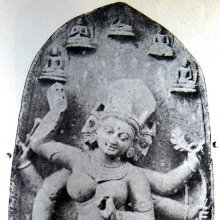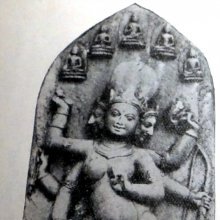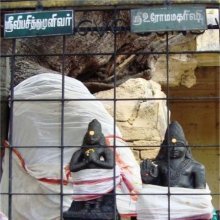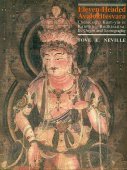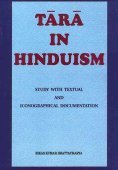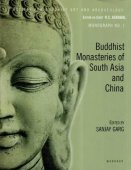Image: 2 definitions
Introduction:
Image means something in Buddhism, Pali, Hinduism, Sanskrit. If you want to know the exact meaning, history, etymology or English translation of this term then check out the descriptions on this page. Add your comment or reference to a book if you want to contribute to this summary article.
Images (photo gallery)
(+2256 more images available)
In Hinduism
Shilpashastra (iconography)
Source: Shodhganga: Elements of Art and Architecture in the Trtiyakhanda of the Visnudharmottarapurana (shilpa)Images of different deities in different forms were worshipped from early period in India.—In Hinduism, the tradition of worshipping of idols has been continuing from early period in India. History shows that from the date of antiquity people used to connect themselves with their lords through the medium of the images of different deities in different forms. Thus the practice of image making had come forward. Different treatises of Sanskrit literature deal with the topic of image making.

Shilpashastra (शिल्पशास्त्र, śilpaśāstra) represents the ancient Indian science (shastra) of creative arts (shilpa) such as sculpture, iconography and painting. Closely related to Vastushastra (architecture), they often share the same literature.
In Buddhism
Tibetan Buddhism (Vajrayana or tantric Buddhism)
Source: Google Books: The Crystal Mirror of Philosophical SystemsImages (symbolizing the Buddha’s mind) refers to one of the “Three Supports” which are known in Tibetan as rten gsum.—Accordingly, [while describing the history of philosophical systems in Mongolia], [regarding Godan and Kublai’s era]: Later on, during the reign of King Mongké (1209–59), Karma Pakshi and others arrived. [...] The king, having obtained from India many examples of the three supports [e.g., Images (symbolizing the Buddha’s mind)], such as Buddha relics and so forth, had temples built, established monasteries, and so spread the teaching.

Tibetan Buddhism includes schools such as Nyingma, Kadampa, Kagyu and Gelug. Their primary canon of literature is divided in two broad categories: The Kangyur, which consists of Buddha’s words, and the Tengyur, which includes commentaries from various sources. Esotericism and tantra techniques (vajrayāna) are collected indepently.
See also (Relevant definitions)
Starts with: Image consecration, Image worship.
Query error!
Full-text (+3163): Pratima, Bimba, Murti, Pratibimba, Pratikriti, Pratishtha, Chaya, Arca, Praticchanda, Cakshurdana, Pratirupa, Pratinidhi, Pratishthapana, Pratiphala, Vishnu, Pranapratishtha, Bera, Praticchaya, Brahma, Shiva.
Relevant text
Search found 471 books and stories containing Image, Images, The image; (plurals include: Images, Imageses, The images). You can also click to the full overview containing English textual excerpts. Below are direct links for the most relevant articles:
Iconography of Buddhist and Brahmanical Sculptures (by Nalini Kanta Bhattasali)
Iconography of Gauri < [Part 2 - Brahmanical Sculptures]
Iconography of Nataraja < [Part 2 - Brahmanical Sculptures]
Iconography of Vishnu < [Part 2 - Brahmanical Sculptures]
Agni Purana (by N. Gangadharan)
Chapter 55 - The characteristics of the pedestal (piṇḍikā-lakṣaṇa)
Chapter 43 - Installation of deities in the temples
Chapter 51 - Characteristics of the images of the Sun and other planets
Matsya Purana (critical study) (by Kushal Kalita)
Part 3 - Art in the Matsyapurāṇa < [Chapter 7 - Art and Architecture in the Matsyapurāṇa]
Part 5.1 - The sixteen Mahādānas < [Chapter 4 - Religious aspects of the Matsyapurāṇa]
Part 4 - Imagery in the Matsyapurāṇa < [Chapter 2 - Literary aspect of the Matsyapurāṇa]
Vietnamese Buddhist Art (by Nguyen Ngoc Vinh)
6. Avalokitesvara images in Indonesia < [Chapter 3 - Unifying factors of the Avalokitesvara Images in South Vietnam and South East Asia]
3. Avalokitesvara images in Funan < [Chapter 3 - Unifying factors of the Avalokitesvara Images in South Vietnam and South East Asia]
5. Avalokitesvara images in Thailand < [Chapter 3 - Unifying factors of the Avalokitesvara Images in South Vietnam and South East Asia]
Jainism in Odisha (Orissa) (by Ashis Ranjan Sahoo)
Iconography of Tirthankaras < [Chapter 6]
Jaina Antiquities in Choudwar (Cuttack) < [Chapter 3: Survey of Jaina Antiquities in Odisha]
Jaina Antiquities at Narasinghpur (Jajpur) < [Chapter 3: Survey of Jaina Antiquities in Odisha]
Vedic influence on the Sun-worship in the Puranas (by Goswami Mitali)
Part 9 - Iconographic Traces of Sūrya in the Purāṇas < [Chapter 4 - Vedic Influence on the Sun-Worship in the Purāṇas]
Part 8 - Mode of Worship < [Chapter 4 - Vedic Influence on the Sun-Worship in the Purāṇas]
Part 10 - Temples and Pilgrimages for Worshipping the Sun-god in the Purāṇas < [Chapter 4 - Vedic Influence on the Sun-Worship in the Purāṇas]
Related products
(+6 more products available)
